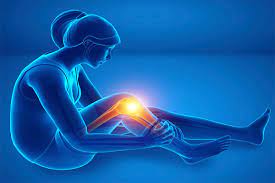Acute Pain: What it, Symptoms, Definition, Treatment

What Is An Acute Pain?
Acute pain is a type of pain that is typically sharp and severe, and usually has a sudden onset. It is usually caused by injury, surgery, or an underlying medical condition, and typically lasts for a short period of time, ranging from a few days to a few weeks. It is often described as a “warning signal” that the body uses to alert the individual to the presence of an injury or other problem that needs to be addressed. Acute pain can be treated with a variety of medications and other therapies.
Acute Pain Symptoms
Acute pain symptoms may include:
Sharp or stabbing pain
Soreness or tenderness
Aching or throbbing
Stiffness or swelling
Limited range of motion or difficulty moving the affected area
Bruising or redness
Numbness or tingling
Weakness or fatigue
Headache
Dizziness
Nausea
Rapid heartbeat
Anxiety or depression
Symptoms may vary depending on the cause and location of the pain. It’s important to note that this list is not exhaustive and one may experience different symptoms. If the pain becomes severe, persists for a prolonged period of time, or is accompanied by other symptoms such as fever or difficulty breathing, it is important to seek medical attention.
Acute Pain examples
Acute pain can be caused by a wide variety of conditions and injuries, some examples include:
Broken bones
Sprains and strains
Dental work
Surgical procedures
Childbirth
Kidney stones
Appendicitis
Gallbladder inflammation
Migraine headache
Toothache
Shingles
Burns
Sunburn
Cuts and scrapes
Insect bites
Injuries from sports or accidents
These are just a few examples of the many potential causes of acute pain. It is important to note that the cause of acute pain is not always immediately obvious, and a diagnosis may require further evaluation and testing.
Acute Pain Management
Acute pain management typically involves a combination of medications and other therapies. The specific treatment plan will depend on the cause and severity of the pain, as well as the individual’s medical history and other factors. Some common methods for managing acute pain include:
Medications: Over-the-counter pain relievers such as ibuprofen and acetaminophen, as well as prescription painkillers, can help to reduce pain and inflammation. Opioids may be used for severe acute pain, but they have a high risk of addiction and have to be used with caution.
Physical therapy: Gentle exercises, stretches, and other physical therapy techniques can help to reduce pain, improve range of motion, and promote healing.
Ice or heat: Applying ice or heat to the affected area can help to reduce pain and inflammation.
Rest: Getting plenty of rest and avoiding activities that may aggravate the pain can help to promote healing.
Relaxation techniques: Techniques such as deep breathing, meditation, and yoga can help to reduce stress and improve overall well-being.
Acupuncture, Chiropractic, Massage therapy
It is important to work closely with a healthcare provider to develop a comprehensive treatment plan that is tailored to the individual’s specific needs. In some cases, the acute pain may be caused by an underlying condition that needs to be treated in order for the pain to be fully resolved.
Acute pain definition
Acute pain is a type of pain that typically comes on suddenly and is severe. It is usually caused by an injury, surgery, or underlying medical condition, and typically lasts for a short period of time, ranging from a few days to a few weeks. Acute pain serves as a warning signal, alerting the individual to the presence of an injury or other problem that needs to be addressed. It can be sharp or dull, aching, stabbing or burning and it can be accompanied by other symptoms such as swelling, stiffness, or limited range of motion. Acute pain can be treated with a variety of medications and other therapies, and it is important to work closely with a healthcare provider to develop an effective treatment plan.
Acute pain treatment
Acute pain treatment typically involves a combination of medications and other therapies. The specific treatment plan will depend on the cause and severity of the pain, as well as the individual’s medical history and other factors.
Medications: Over-the-counter pain relievers such as ibuprofen, naproxen, and acetaminophen, as well as prescription painkillers, can help to reduce pain and inflammation. Opioids may be used for severe acute pain but they have a high risk of addiction and have to be used with caution.
Physical therapy: Gentle exercises, stretches, and other physical therapy techniques can help to reduce pain, improve range of motion, and promote healing.
Ice or heat: Applying ice or heat to the affected area can help to reduce pain and inflammation.
Rest: Getting plenty of rest and avoiding activities that may aggravate the pain can help to promote healing.
Relaxation techniques: Techniques such as deep breathing, meditation, and yoga can help to reduce stress and improve overall well-being.
Acupuncture, Chiropractic, Massage therapy
Surgery : In some cases, the acute pain may be caused by an underlying condition that needs to be treated surgically.
It is important to work closely with a healthcare provider to develop a comprehensive treatment plan that is tailored to the individual’s specific needs. Additionally, it is important to monitor and evaluate the effectiveness of the treatment, and make adjustments as necessary. Best Medicine Tapal 100mg And tydol 100mg
Acute pain vs chronic pain
Acute pain and chronic pain are two distinct types of pain that have different causes, characteristics, and treatment approaches.
Acute pain is a normal response to injury or tissue damage, and it is typically sharp and severe. It usually has a sudden onset and lasts for a short period of time, ranging from a few days to a few weeks. Acute pain serves as a warning signal, alerting the individual to the presence of an injury or other problem that needs to be addressed. It can be treated with over-the-counter pain relievers, prescription medications, physical therapy, and other therapies.
Chronic pain, on the other hand, is pain that persists for longer than 12 weeks and it’s usually caused by an underlying condition or injury that has not fully healed. It is characterized by persistent, ongoing pain that can be mild or severe and can be accompanied by other symptoms such as fatigue, sleep disturbances, and depression. Chronic pain may be treated with a combination of medications, physical therapy, counseling, and other therapies. It can be challenging to treat, and it may require a multidisciplinary approach that includes specialists such as pain management doctors, physiotherapists and psychologists.
In summary, acute pain is a normal response to injury or tissue damage, and it is typically sharp and severe. It usually has a sudden onset and lasts for a short period of time, while chronic pain is pain that persists for longer than 12 weeks, may be caused by an underlying condition or injury and can be challenging to treat.
guidelines on pain management
There are several guidelines and recommendations for the management of pain, including:
The World Health Organization (WHO) recommends a “stepped care” approach to pain management, which involves starting with the least invasive and most cost-effective treatments first, and gradually moving to more invasive or costly treatments as needed.
The American College of Physicians (ACP) recommends the use of non-pharmacologic therapies as first-line treatments for low back pain, such as exercise, multidisciplinary rehabilitation, acupuncture, and mindfulness-based stress reduction.
The American Society of Anesthesiologists (ASA) recommends a “patient-centered” approach to pain management that takes into account the individual’s unique needs and preferences.
The American Academy of Pain Medicine (AAPM) recommends the use of a “multimodal” approach to pain management, which involves using a combination of different types of treatments to achieve the best results.
The Joint Commission (TJC) recommends the use of a “pain assessment and management” standard, which requires healthcare organizations to evaluate and treat pain as a “fifth vital sign” and to have policies and procedures in place to ensure the appropriate assessment and management of pain.
It is important to note that these guidelines are not exhaustive, and the treatment plan may vary depending on the specific condition, individual case and the healthcare provider’s experience. Therefore, it is important to consult with a healthcare professional to develop an appropriate pain management plan.





